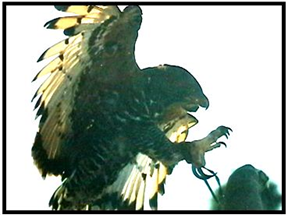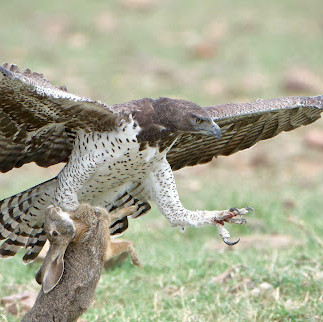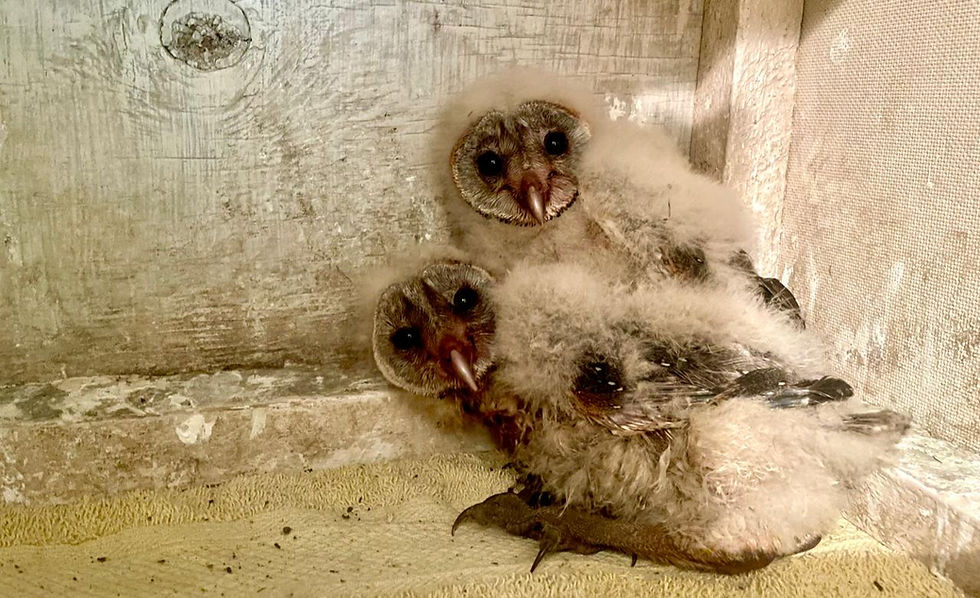Toes and talons
- Kenya Bird of Prey Trust

- Mar 13, 2022
- 4 min read
Raptors are separated from all non-raptor birds by the size of their claws, in raptors called talons, especially the talon on digit #2. Bird toes are counted from the thumb at the rear (first digit or hallux in raptors), to the inside front toe (second digit) and so on. Contrary to non-raptor birds, the talon on the second digit of all raptors is as large or larger than the talon on the third digit.
Also, the talon on the first digit (hallux) is almost always larger than the three forward facing talons. It has the largest muscles dedicated to that one toe and it is the one that stabs the deepest. These features have independently evolved in all raptor clades, from Falconidae to Strigiformes and from Pandionidae to Accipitridae and are assumed to be related to their predatory behaviour.

Drawing of a Crowned Eagles foot, showing the large talon on the second digit, by Simon Thomsett.
Bird catchers
A biologist can look at the foot of a raptor and tell what prey species it kills. It helps to bounce some ideas off the length of the leg, and the shape of the bill, before drawing conclusions.
Long and slim toes in general and a very long third digit, with medium sized needle-like talons are an indicator that a raptor hunts birds. Birds are agile and the bigger the span of the foot, the easier it is to grab a flying object. Birds are also quite fragile so the hunter does not need great squeezing power to overcome them.
The genus of both Falco and Accipiter are avivores and both have independently evolved elongated narrow toes, in particular the third middle toe.
Interestingly, the adult African Peregrine (Falco peregrinus minor) shows an enormous long middle toe, longer than for example the migrant Russian Peregrine (Falco peregrinus calidus) which is much bigger. So the biologist would need to question why, within the same species, two races have such different sized toes.
Snake catchers
When your preferred prey is snakes, you don’t need a large foot to grab it, rather you need thick strong toes to crush the snake’s spine. That's why snake-eagles have short but thick strong toes. To protect them against snakebites their legs are covered in thick scales, another indicator of it being a snake catcher.

Western Banded Snake-Eagle by Peter Steward
Fish catchers
When you look at the feet of piscivorous raptors you will notice that all four talons are about the same size and shape - all very large and highly curved. Unlike other raptors, Ospreys and Fish eagles use all talons to impale their prey. Fish are slippery and very strong so they need all talons to firmly hook into the prey to keep hold of it while it's struggling to escape. The surface of the underside of their feet is rough with sharp protrusions called ”spicules” and these too help catch and hold slippery fish. When one departs entirely from the raptors and sees that the Fishing Owls too share these same features, one has a perfect example of parallel evolution.

African Fish-eagle, by Shiv Kapila
Large prey killing raptors
Large prey can't be immobilised by completely enclosing it within a raptor's feet. Raptors that hunt large prey (relative to their own size) therefore need strong toes and huge talons to maintain a good grip - keeping the talons latched into its prey and delivering fatal stabbing wounds to the internal organs.
The talons on digits 1 and 2 are hypertrophied and vital instruments to hold on to its prey and gain the upper hand. In practice the velocity of impact plays a crucial role in delivering the initial deepest stab. It is for this reason the hind talon faces forward and that the forward momentum stabs the talon into the victim. The talons on the three forward facing toes hold the animal in place while the hind talon does the major damage. The Crowned Eagle, for example, can push a 10cm hind talon right into a thick skinned animal.
Dead prey
When you’re a scavenger like most vultures, you don’t need strong feet or sharp talons to kill your prey. And although vultures' feet are not strong, they do have big feet to provide them a big base to enable a lateral pull at a carcass. They also can do a dead weight lift with their necks and legs of over 30 kg…lifting an entire gazelle off the ground if they forgot to stand on it.

Lappet-faced Vultures, by Lemein Par
Nocturnal hunters
All but a few owls hunt relatively small prey that can be restrained within the foot. Most owls therefore have short and robust toes and relatively long talons to give them maximum leverage for securing small prey. When caught the prey is either constricted by the foot or killed with its beak.
The European Scops Owl and Wood Owl are tiny and they kill tiny things like insects, geckos, small lizards and small rodents. The Mackinder’s Eagle Owl, while smaller than a Verreaux’s Eagle Owl, has much bigger feet. The massive feet make this owl capable of routinely killing hares and hyraxes.
Wish to learn more, visit our website and join us on Facebook and Instagram.
Kenya Bird of Prey Trust
Understand - Protect - Restore























Comments